How Are Diamonds Made? Natural vs Lab-Created Explained
Two Paths, One Diamond Not all diamonds come from the same place — but they all start the same way. Pure carbon, crystalized under immense pressure and heat. Whether it…
Moissanite vs Diamond
Moissanite is a diamond simulant, meaning that it simulates the aesthetics of a gem-quality diamond while having different optical, physical, and chemical properties. Natural moissanite is extremely rare, so the moissanite gemstones you’ll find on the market are laboratory-created.
Before going on: Check out the PriceScope Diamond Buying Guide
These pages may reference products from companies that help to support PriceScope.
Diamonds are made of carbon. Moissanite is synthesized gem quality silicon carbide. While they appear similar, to the casual viewer, there are distinct differences in their physical composition and nuanced appearance.
In 1893 Nobel Prize winning scientist Henri Moissan found a 50,000 year-old meteorite in the Arizona desert. Hidden within the meteorite’s fragments was a new mineral, first thought to be diamond, which turned out to be natural silicon carbide (SiC). In 1905 Tiffany & Company gemologist George Kunz suggested it be named moissanite in Dr. Moissan’s honor. Natural moissanite is extremely rare. Until the 1950s it was only thought to exist in meteorites, until discovered in Wyoming, USA, and far eastern Russia. Extraterrestrial origins are how moissanite gemstones earned the nickname “Space Diamonds.”
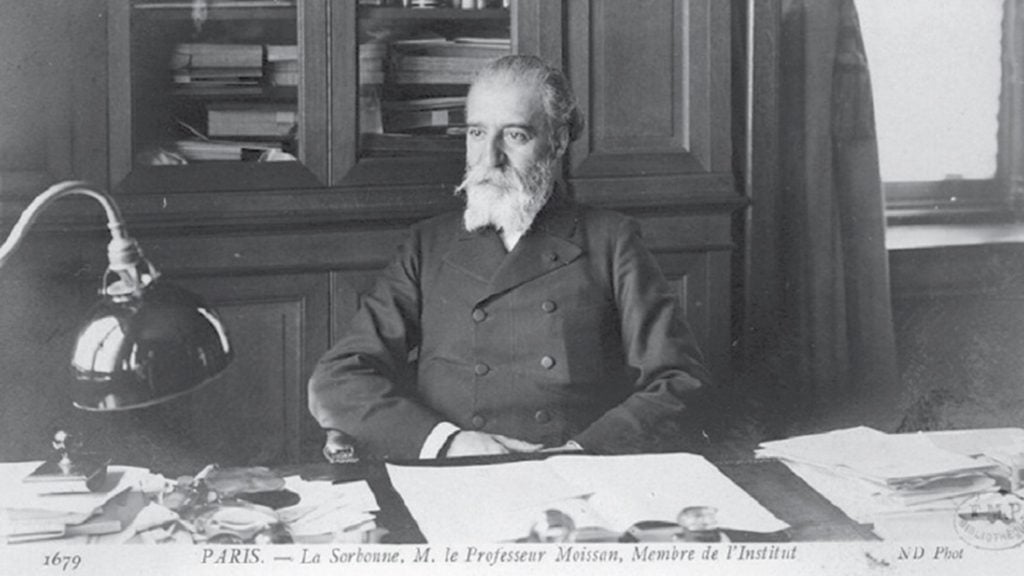
In 1998 Charles & Colvard, the original source of gem quality moissanite, introduced laboratory created SiC to the jewelry market. Over the years, it gained popularity as a diamond simulant due to its close appearance and a lower price point. The Charles & Covard patent expired in 2015, permitting other manufacturers to enter the market. In addition to moissanite created for jewelry applications synthetic SiC, also known as carborundum, is used in high tech ceramics, electrical components, abrasives, ball bearings, semi-conductors, extremely hard saws, and armor.
| Moissanite | Diamond | |
| Hardness | 9.25 | 10 |
| Brightness | Transparent, reflective | Transparent, reflective |
| Dispersion | 2.654 – 2.967 | 2.417 |
| Color | Near-colorless + fancy colors | D-Z range + fancy colors |
| Clarity | VS+ on average | Flawless to heavily included |
| Carat weight | 15% lighter | – |
| Cut quality | VG+ on average | Ideal to Poor |
| Price | 50% of lab-grown, 10-20% of natural | – |
Wondering which of the many diamond vendors is best for you? Our elite list of vetted vendors like Whiteflash and James Allen are experts at listening and helping you determine which combo of the 4Cs is perfect for you - and nicely in budget. Contact Us and get help today.
Moissanite and diamond have similar optical properties. In fact, it wasn’t until 1904, nearly a decade after finding the mineral in rock samples from a meteor crater in Canyon Diablo, Arizona, that Dr. Moissan correctly identified the crystals he had discovered as silicon carbide. At first, he had presumed they were diamond.
Natural and lab-grown diamonds score 10 on the Mohs scale and are the hardest known substance on earth. The next hardest mineral, with a score of 9, is corundum which jewelry enthusiasts know as ruby and sapphire. However, diamond’s 10 is nearly 10X as hard as corundum’s 9. Moissanite scores 9.25 on the Mohs scale, which is an exceptional score, making them more than suitable for daily wear as a durable gemstone. The only material that will scratch moissanite is diamond, or another moissanite.
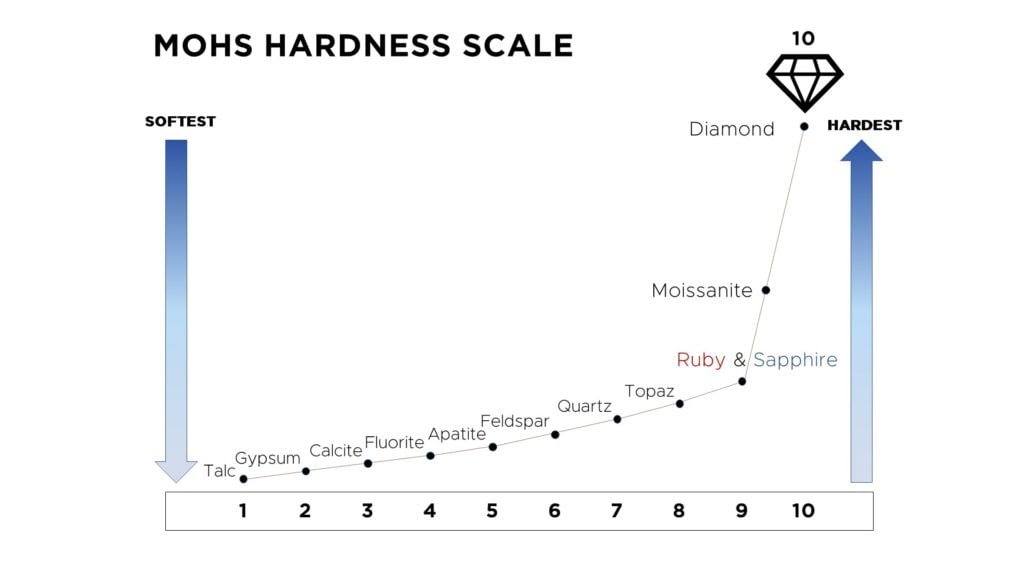
Moissanite enjoys the same transparency, brilliance, and reflective properties as diamond.
Moissanite has a refractive index of 2.654 – 2.967, which is higher than diamond’s refractive index of 2.417. The result, if all other aspects are equal, is that moissanite displays more spectral color or “fire” in lighting favorable for producing sparkle/scintillation than diamond. {reference other articles} The difference between the two is subtle but noticeable, especially to those who have experience analyzing diamonds and gemstones.
Moissanites are not graded for color like other gemstones, but they are not entirely colorless. Most moissanite resembles diamonds in the near-colorless (GHIJ) range, although more colorless moissanite can be found. Moissanite also tends to come with a green, yellow, or gray undertone which gets easier to see at larger weights and under diffused lighting. Sellers typically describe moissanite they’re selling as near-colorless moissanite or colorless moissanite.
Clarity grades a gemstones freedom from external blemishes and internal inclusions, sometimes called imperfections. Moissanite gemstones are not graded by a gemological laboratory applying consistent, internationally accepted standards so a moissanite gemstone’s freedom from imperfections is typically declared by the producer or seller.
The average clarity of moissanite used in jewelry is comparable vs clarity in diamonds, meaning very slightly included. The most common inclusions in moissanite are micro-pipes, faint crystals, and small feathers. These are typically invisible to the naked eye and can be difficult to find with magnification in many cases.
The carat is the traditional unit of measurement for gemstone weight. Moissanite weighs less than diamond, by about 15%, so moissanite is typically promoted using size in millimeters and “diamond equivalent” weight in carats. This is a practical way to promote moissanite, since identically sized moissanite and diamond will be listed as equivalents.
The shape and cut quality of any moissanite will play a large role in its optical performance. Step cut shapes like emerald and Asscher do not promote dispersion as well as the round brilliant, which means moissanite in those shapes has more similar appearance to diamond. When cut to shapes like marquise and oval the increase in fire is more noticeable and is especially distinct in well-cut round and cushion configurations.
Average moissanites gemstones tend to be better cut than average diamonds. This is because inclusions, crystal structure and the economics of yield drive diamond cutting decisions. Those things don’t have such influence in the planning and fashioning of moissanite.
Currently, high-quality moissanite sells for around 50% the price of equivalent near-colorless, VS-clarity, excellent cut lab-grown diamonds and around 10-20% the price of equivalent near-colorless, VS-clarity, excellent cut natural diamonds. Like lab-grown diamonds, the affordability of moissanite as a natural diamond alternative makes it appealing to some people.
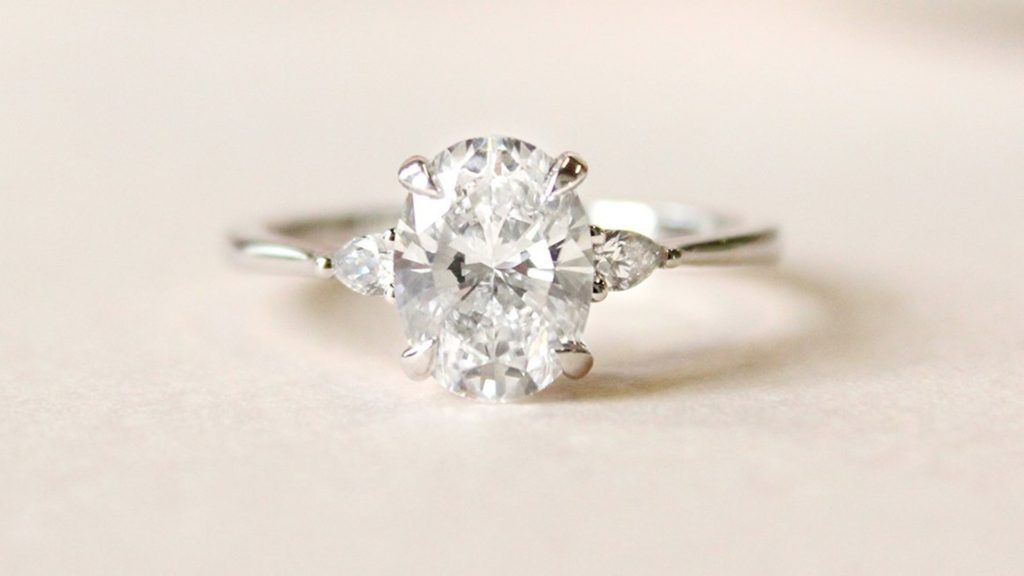
PriceScope’s 1-5 star ratings are categorical comparisons with the most thorough, consumer-focused online diamond and jewelry vendors, in categories, we believe reflect our experienced consumer community’s values. Check out PriceScope Jeweler Reviews.
Diamond testers which measure thermal conductivity are frequently fooled by moissanite, which also has good thermal conductivity, so they are not recommended as a good way to detect moissanite. Testers which use electrical conductivity are more effective at separating the two. Just be aware that certain lab-grown diamonds are produced with strong electrical conductivity.
Unlike diamond, moissanite is birefringent or doubly refractive. This means light entering the stone splits into two separate beams. Experienced gemologists can easily separate moissanite from diamond with a magnifying loupe, looking through the stone at an angle and inspecting the culet or facet junctions to see if they appear twice, or are blurred, compared to the crisp, single appearance a diamond’s culet and facet junctions have when inspected the same way.
Moissanite weighs approximately 15% less than diamond. This isn’t something the average person will detect but a high precision jewelry scale will reveal the difference between moissanite and a diamond of the same size. Moissanite is typically promoted using the size in millimeters and “diamond equivalent” weight in carats. This is a practical way to promote moissanite since identically sized moissanite and diamond will be listed as equivalents.
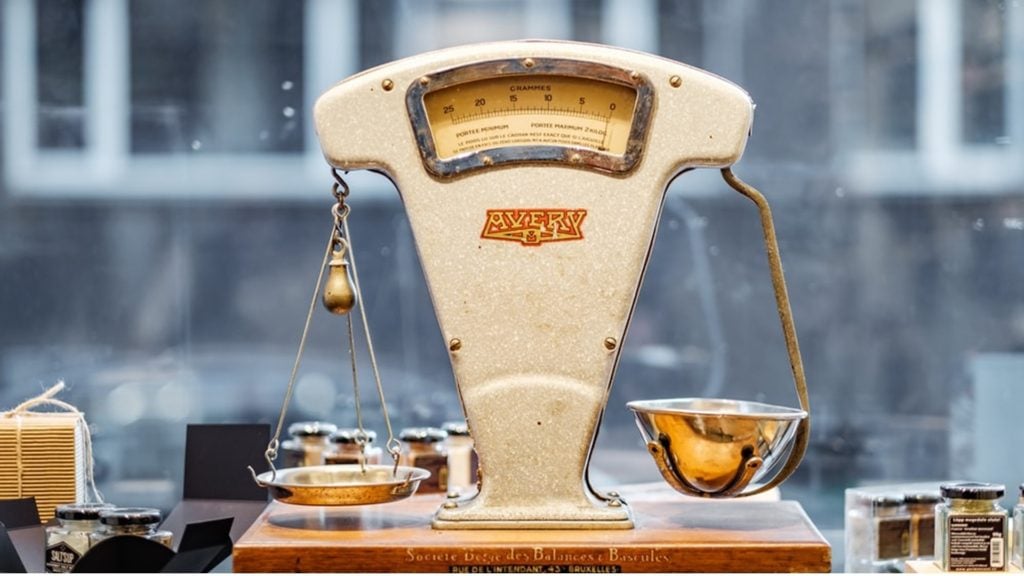
Moissanite has gained popularity since its introduction. There are many moissanite rings designed for fashion, as well as moissanite engagement rings. Some sellers offer moissanite products, exclusively, while other sellers offer moissanite as an option, along with more common natural and lab-grown gemstones. Here are a few reasons someone may be tempted to choose moissanite rather than a diamond.
If you like colored flashes, the aesthetic of moissanite may appeal to you as much or more than diamond.
For the same apparent size, moissanite prices are significantly under diamond prices, as well as the prices of many other gemstones. A near-colorless, VS-clarity excellent cut natural diamond costs nearly 10X the price of equivalent moissanite. A near-colorless, VS-clarity excellent cut lab-grown diamond costs around 2X the price of equivalent moissanite.
All available moissanite is produced responsibly, in controlled factory settings. There is no mining involved and they require less energy to create than lab-grown diamonds, giving them a smaller carbon footprint than natural and lab-grown diamonds.
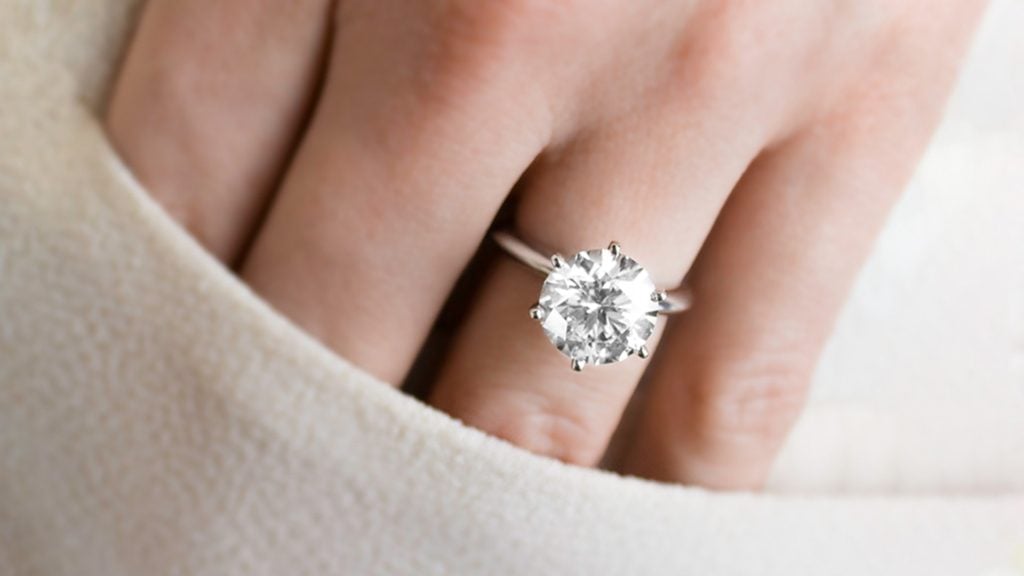
Just as some people may be attracted to the look, origin, and affordability of moissanite, there are a variety of things other people consider disadvantages, compared to diamond.
Where one person likes the higher dispersion of moissanite another may think it looks artificial or simply “off.” Experienced jewelry professionals and enthusiasts can easily identify moissanite as a diamond simulant, in some cases more definitively than cubic zirconia, precisely because the rainbow dispersion is somewhat exaggerated and different.
Those who like the “forever” symbolism of natural diamonds may not be prepared to embrace moissanite as a token of emotional or social connection. Culturally, the historic association of diamonds and gemstones with supernatural powers, the gods, nature, and love doesn’t exist with moissanite.
Consumers are not typically able to cash in diamonds for what they paid, but natural diamonds do tend to hold and increase in value over time. There is also a concrete cost basis, for even a small diamond, which signifies a spend – often in the thousands of dollars – so the diamond is a store of value. Moissanite has fractional value, by comparison, and the secondary market for moissanite is not nearly what it is for those looking to sell a diamond.
PriceScope’s 1-5 star ratings are categorical comparisons with the most thorough, consumer-focused online diamond and jewelry vendors, in categories, we believe reflect our experienced consumer community’s values. Check out PriceScope Jeweler Reviews.

Moissanite and lab-grown diamonds are both produced by humans in factories.
Unlike moissanite stones, lab-grown diamonds are real diamonds. They are not simulants which is how moissanite and CZ are classified. Aside from subtle carbon distinctions, a lab-grown diamond is optically, physically, and chemically identical to a natural diamond. The technical difference is that they are not billions of years old. They are grown in factories using sophisticated chemical synthesis over a period of 1-4 weeks. Once grown, they are polished with the same tools and brought to market in the same manner as natural earth-mined diamonds.
Lab-grown diamonds trade for much lower prices than comparable natural diamonds and it’s likely to presume they will continue becoming more and more cost-effective. There are also strong players like DeBeers entering the market with disruptive pricing. As long as retail prices continue dropping, the value of lab-grown diamonds will also drop. This is good news for those who agree with the benefits of lab-grown diamonds.
Read More About Lab-Grown Diamonds
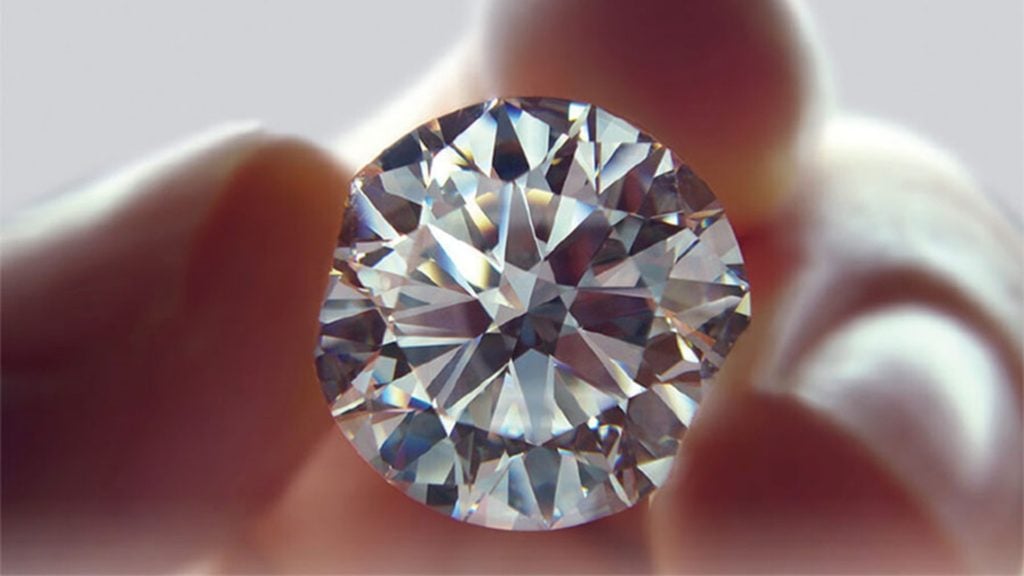
Moissanite can be a great choice for couples that are cost conscious, looking for a gemstone with a small carbon footprint, or even seeking a temporary stone for an engagement ring that can be replaced later. They have an extremely high hardness on the Mohs scale, just 0.75 below diamond and 0.25 above ruby and sapphire, so they are well suited to people who don’t like to remove their rings when doing gardening, exercise, cleaning, or other hand-intensive or active work.
Get fast answers to any question: Ask our community of unbiased independent helpers or use our diamond search to find your ideal diamond.
Ready To Find Your Diamond?
People Also Ask
The average carat weight for an engagement ring in the U.S. is between 1.00 carat and 1.08 carats. To balance carat weight against the other Cs, especially all-important cut quality, read the PriceScope Diamond Buying Guide.
Check out our Diamond Price Guide to see how different factors impact a 1 carat diamond’s price. We have also included a diamond price calculator for you to see today’s prices in real-time, based on more than 500,000 diamond listed in our search engine.
Carat is a weight, but two diamonds of the same carat weight can appear to be different sizes, depending on both their physical spread as well as their less-discussed visual spread. Learn how to select a diamond that remains bright from edge to edge on our page on Diamond Cut.

Retail Diamond Prices Chart Updated Monthly.

Two Paths, One Diamond Not all diamonds come from the same place — but they all start the same way. Pure carbon, crystalized under immense pressure and heat. Whether it…
A Wedding Ring as Unique as Your Love Finding the right wedding ring isn’t just about diamonds or gold – it’s about finding the one that feels right. With hundreds…
So, you’re thinking about lab-grown diamonds? Smart move. They’re just as sparkly as the natural kind but usually cost less. But where do you actually go to buy them? It…

Want to stay updated on the most recent blogs, forum posts, and educational articles? Sign up for Bling News, PriceScope’s weekly newsletter.